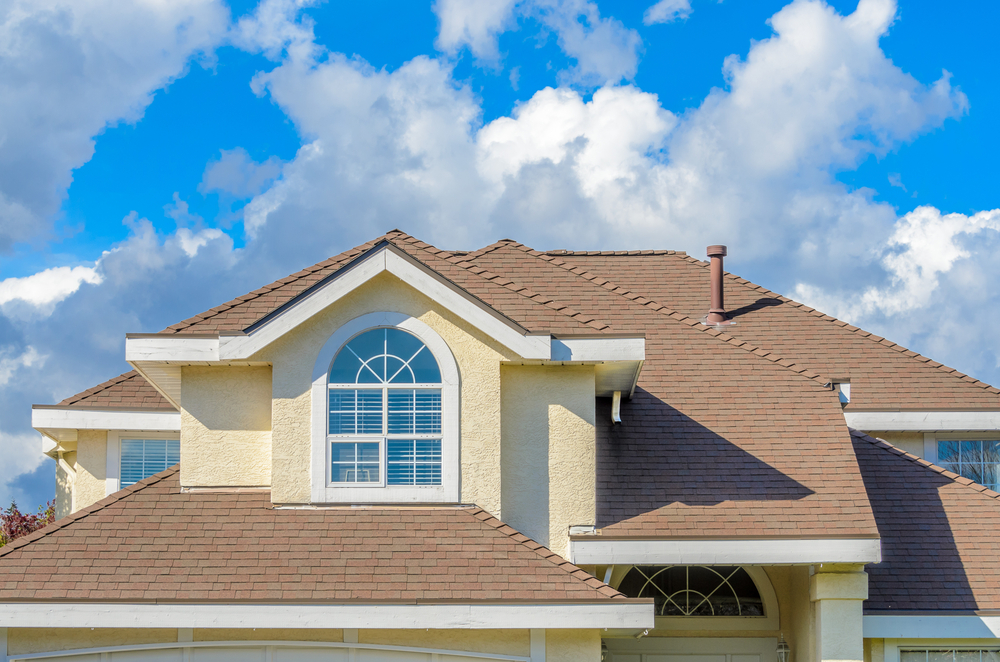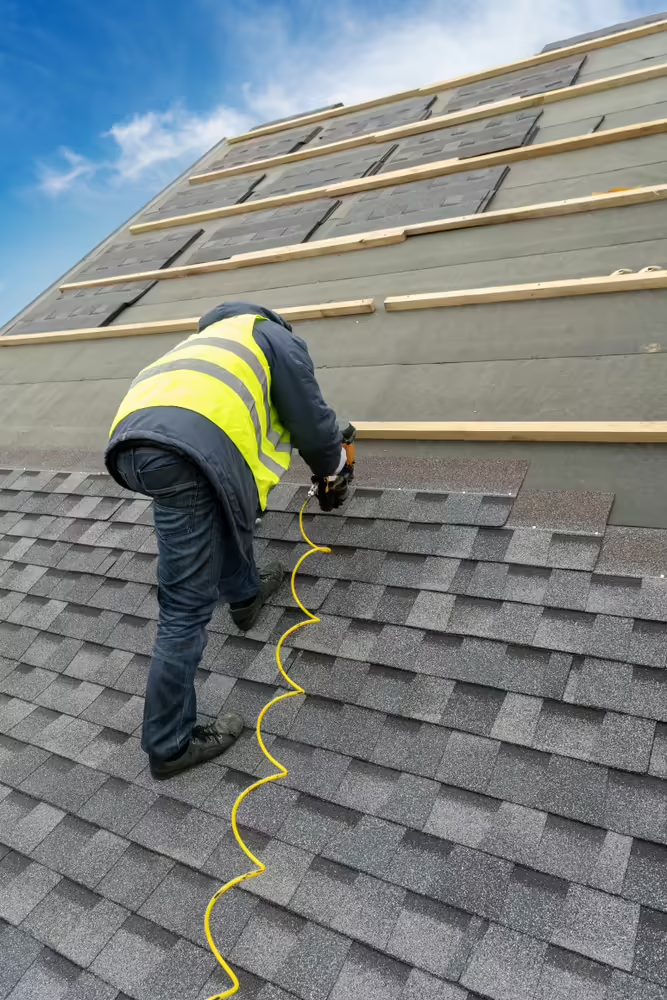Thinking about getting a new roof can be a little scary. Questions like “What is included in a roof replacement?”, “Am I getting ripped off?” or “What if they mess up my house?” probably swirl in your head. I’ve been there so many times over the last several years. Well, this is precisely why you need a guide: to illuminate the crucial aspects of roof replacements. We’ll remove the fear of the unknown, equip you with the knowledge to ask the right questions and give you confidence as you tackle this home improvement project. You need a roof that not only looks great but protects what matters most – your family. Knowing what is included in a roof replacement lets you make informed choices.
Roof Replacement: It’s More Than Just Shingles.
Most homeowners picture a bunch of guys ripping off the old shingles and nailing down new ones. While that’s part of it, a complete roof replacement goes way deeper – literally. Let’s uncover those hidden layers and components, like a good roofing contractor would after removing your old shingles.
The Foundation: Decking, Underlayment, and Why They Matter
Just like a house needs a solid foundation, so does your roof. That foundation starts with the roof deck, also known as roof sheathing.
This is usually made up of plywood or oriented strand board (OSB) panels fastened directly to your roof rafters. Over time, water damage or just plain old age can lead to rot or weakening, making replacement essential for a sound roof. This is especially true if you have standard 3-tab asphalt shingles on your roof, as they provide less protection than architectural shingles.
Next comes the underlayment. It sits on top of the decking, providing that initial line of defense against moisture. Think of it as a safety net to minimize damage in case water can sneak past your shingles. There are various types of underlayment, with synthetic options gaining popularity due to their durability. Organic or felt underlayment, although less expensive, might not provide the same level of protection, especially with extreme weather becoming more common.
Ice and Water Shield: Shielding You From Nature’s Fury
Moving up, we come to a vital yet often overlooked component – ice and water shield.
This rubberized membrane gets installed in areas most prone to leaks – valleys where roof slopes meet, around those pesky pipe penetrations, and even along roof edges in colder climates prone to ice damming. You might question the cost, but trust me, this extra layer of protection is well worth it. Some insurance companies offer discounts to homeowners with ice and water shields because it dramatically reduces the risk of interior damage.
Flashing: Directing Water Away Like a Pro
Now, let’s talk flashing. Imagine a roof without it. It’s a recipe for disaster, a bit like wearing a raincoat with holes.
Flashing is a thin metal material, usually, aluminum or steel, installed at critical points like roof valleys, edges, and around penetrations (like chimneys or vents). Why’s it so crucial? Because it prevents water from seeping into your home’s structure. Remember the old saying, “Water always finds a way”? Well, flashing ensures it flows down and off the roof, where it belongs, not inside, ruining your dry walls and causing potential mold growth.
Ventilation: Keep Your Attic Breathing Easy
Believe it or not, proper ventilation plays a vital role in the lifespan of your roof. A well-ventilated attic helps regulate temperature and moisture levels, preventing problems like premature shingle deterioration, mold growth, and even ice dams in winter. Essentially, it allows your roof to breathe.
There are various types of ventilation systems, but whether you opt for ridge vents, box vents, or a combination, adequate airflow is key. For instance, in regions with heavy snowfall, installing a ridge vent along the peak of the roof paired with soffit vents at the eaves can create a continuous flow of air, effectively reducing the risk of ice dams.
Choosing the Right Shingles: It’s a Matter of Style AND Performance.
Finally, the part everyone thinks about when getting a new roof is the roofing material. Asphalt shingles are still the most common, but there’s a surprisingly wide range to choose from, each with pros and cons:
| Shingle Type | Pros | Cons |
| 3-Tab Asphalt | Affordable, readily available | Shorter lifespan, less wind resistant |
| Architectural (Dimensional) Asphalt | Enhanced appearance, greater durability | Pricier than 3-tab, requires specialized installation |
| Metal | Extremely durable, energy efficient | Higher upfront costs can be noisy |
| Tile | Long lifespan, low maintenance, fire resistant | Expensive, heavy – might require structural reinforcement |
Your decision should factor in your budget, your home’s style, and weather conditions in your area. Need help choosing? Our skilled roofers in Dawsonville and the surrounding areas are here to help!
Don’t Forget: Cleanup and Disposal
A proper roof replacement involves not just putting on the new but also cleaning up the old. Removing debris ensures the safety of your property and prevents damage. Our team of roofers in Johns Creek can make sure everything is taken care of properly. Disposing of certain materials, particularly if your old roof contains asbestos, should always be done by a professional who follows safety guidelines.
FAQs
What’s involved in having a new roof?
Having a new roof put on your home involves many layers. Your roofing contractor will assess your roof’s condition and decide which layers will need replacement during your new roof installation. If there’s existing damage that goes deeper than the surface, such as rotten wood underneath the shingles, your roofer might need to replace some or all of the roof decking to ensure your new roof has a strong base. Additionally, protective layers like underlayment, ice, water shield, and flashing help prevent leaks and damage. All of these components, combined with proper ventilation and expertly installed shingles, guarantee a long-lasting roof.
Does a new roof include plywood?
It depends on the condition of your existing roof deck. Sometimes, the decking (commonly plywood) is salvageable, and our team will only need to replace damaged sections. But, if there’s widespread rot, water damage, or structural issues, a complete deck replacement is often necessary.
What does a roof plan include?
A detailed roof plan encompasses a variety of components beyond simply deciding what is included in roof replacement. For example, it outlines the roof’s design, including its shape, slope, and the types of materials. It also factors in important elements like ventilation systems, flashing details, and compliance with building codes. A comprehensive plan should include detailed drawings, specifications of all materials used, and a clear outline of the installation process from start to finish. For a new roof in Milton, GA, we can collaborate with you to come up with the perfect roof plan that not only fits your budget but your style, too.
What kind of expense is involved in a new roof?
Replacing your roof is considered a significant home improvement expense. Many sources consider a roof replacement a capital expense rather than a repair expense.
You now have a solid starting point regarding knowing what is included in a roof replacement. Remember, knowledge is your most potent tool. Our reputable roofers will gladly walk you through every step. Ask questions. After all, this is a substantial investment, and ensuring you get the best protection and peace of mind for your home is crucial. Don’t hesitate to contact Award Roofing today for expert advice, top-notch materials, and a roof replacement that stands the test of time. We are the leading experts in all your roof repair, replacement, and installation services in Georgia. We service residential properties as well as commercial properties.

